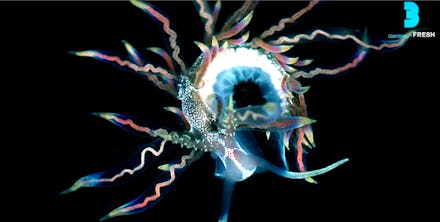5 Weird Animals Science Recently Discovered That Look Like They're Out of a Sci-Fi Movie

It's not an exaggeration, the world is a big place — big enough that, despite all of our years on Earth, we discover new species each and every year. Some of them are a bit more commonplace, like variations of already-found animals, such as wasps (though this particular species eats spiders, which is creepy beyond belief), or small, minute organisms of little interest.
However, within the many, less interesting species we discover, we're prone to find some eye-grabbing new animals as well. Here are five, admittedly weird animals that science has discovered recently.
Read more: 6 Extinct Animals That Were Awesomely Bad Ass — Though Admittedly Quite Dangerous
Yeti crab: Two terms that shouldn't go together, the Yeti crab is an oddly appropriate name. Discovered in 2005, the furry crustacean is found in the South Pacific Ocean, and lives in deep in the ocean — specifically, around the hydrothermal vents. Still, it's furry and adorable, but it's also a crab, so that's pretty weird.
Red-bearded titi: This cute little primate was discovered in the Amazon rainforest in 2008. On the unfortunate flip side, however, it's likely that the species is critically endangered. Some estimates put the population at less than 250 — an unfortunate prospect for an animal living in a habitat that is constantly shrinking due to deforestation.
Pinocchio frog: Clearly, this little guy's told a lot of lies in his life. In all seriousness though, the Pinocchio frog's curious appearance, and the extension that looks like a droopy nose, isn't yet known by scientists. It was only discovered in 2010, within the remote Fuja Mountains in Indonesia. What we do know, though, is that the male Pinocchio frog's nose becomes erect when it is excitedly communicating. No joke.
Lesula: With an expression built for a dramatic soap opera, the Lesula is an African monkey first seen in 2007 in the Democratic Republic of Congo. It might've been discovered by locals in the area prior, however, it was officially discovered by John Hart, a biologist from the Lukuru Wildlife Research Foundation. Interestingly, the Lesula has strikingly human facial features, and always looks seemingly pensive — like it has a thousand stories to share, but doesn't have the words to express them ('cause it's a monkey).
Cartwheeling spider (this is not a drill): If you suffer from arachnophobia, and we absolutely don't judge anybody if you do, this is your only warning to stop reading. For everyone else, a new species of spider was discovered last year. Its scientific name is the Cebrennus rechenbergi, but it's commonly referred to as the cartwheeling spider.
Why such a specific name? Unfortunately, because it actually propel itself off the ground in a cartwheel-esque fashion, which gives it a much-needed, speedy advantage when it comes to hunting down prey. One more warning: you've read about it and it's pretty creepy, but a video of the cartwheeling spider in action is also a thing.